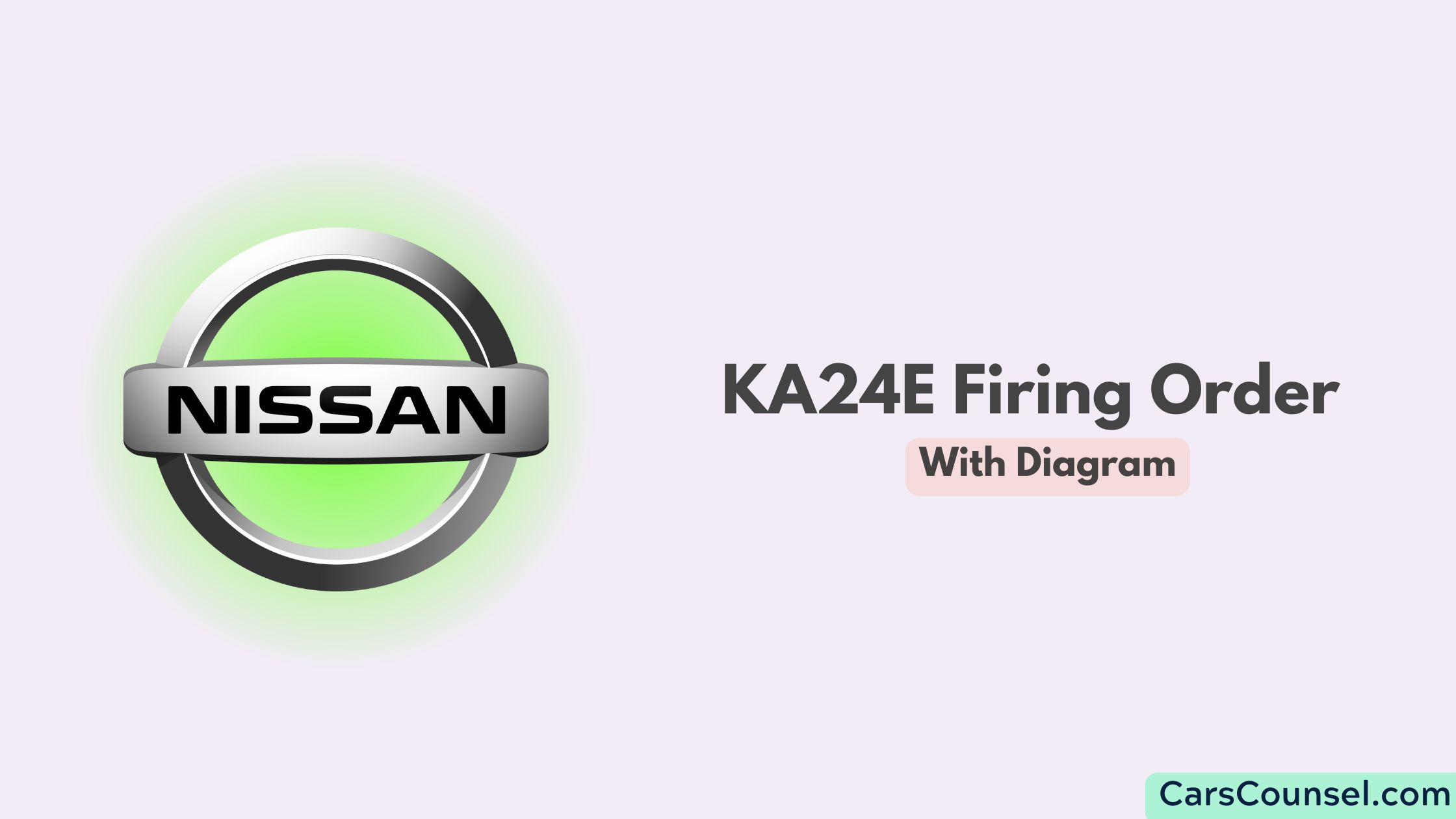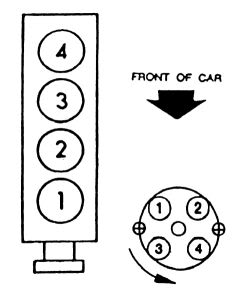
Quick Navigation
What is a Firing Order?
The firing order is the specific sequence in which an engine’s cylinders ignite their air-fuel mixture during the combustion process. For the KA24E engine, the firing order is 1-3-4-2.

This firing order ensures that the power strokes are evenly distributed across the engine’s four cylinders, keeping the engine balanced and running smoothly.
Why the Firing Order Matters
The firing order is a critical aspect of the KA24E’s functionality. Here’s why it’s so important:
- Engine Balance: The firing order ensures that power strokes are evenly spaced, reducing vibrations.
- Smooth Operation: Proper sequencing prevents interruptions in performance, resulting in consistent and reliable power delivery.
- Efficiency: Correct ignition timing maximizes combustion efficiency, improving fuel economy and reducing emissions.
- Durability: Balanced operation reduces stress on engine components, extending their lifespan.
- Power Delivery: The firing order maintains consistent torque output, essential for smooth acceleration and performance.
Disruptions to the firing order can lead to noticeable performance issues, such as misfires, rough idling, or loss of power.
The KA24E Firing Order: 1-3-4-2
The KA24E firing order, 1-3-4-2, is designed for its inline-four-cylinder configuration. Here’s how it works step-by-step:
- Cylinder 1 Fires First: The sequence begins with Cylinder 1 igniting its air-fuel mixture during the power stroke.
- Cylinder 3 Fires Next: Cylinder 3 ignites, maintaining the rhythm of the cycle.
- Cylinder 4 Engages: Cylinder 4 fires, contributing to the engine’s smooth operation.
- Cylinder 2 Completes the Cycle: Finally, Cylinder 2 fires, and the sequence repeats.
This firing order is specifically designed to balance power delivery, minimize engine vibrations, and ensure efficient operation.
How the Firing Order Works in the KA24E Engine
The KA24E engine operates on a four-stroke cycle, which consists of the following stages:
- Intake Stroke: The intake valve opens, allowing the air-fuel mixture to enter the cylinder.
- Compression Stroke: The piston compresses the mixture, preparing it for ignition.
- Power Stroke: The spark plug ignites the compressed mixture, creating an explosion that drives the piston downward to generate power.
- Exhaust Stroke: The exhaust valve opens, releasing spent gases from the cylinder.
The firing order synchronizes these stages across all four cylinders, ensuring that power strokes are evenly distributed and that the engine delivers smooth, consistent power.
Key Components Supporting the Firing Order
Several components in the KA24E engine work together to maintain the correct firing order. Here’s how these components contribute:
- Crankshaft: Converts the pistons’ vertical motion into rotational energy, driving the sequence of power strokes.
- Camshaft: Times the opening and closing of the intake and exhaust valves to align with the firing order.
- Distributor: Directs electrical signals to the spark plugs in the correct firing sequence, ensuring proper ignition timing.
- Spark Plugs: Ignite the air-fuel mixture in each cylinder at precisely the right time.
- Timing Chain: Synchronizes the crankshaft and camshaft, maintaining proper firing order and valve timing.
When these components work harmoniously, the engine runs efficiently and reliably.
Symptoms of Firing Order Problems
If the KA24E’s firing order is disrupted, the engine will exhibit noticeable performance issues. Common symptoms include:
- Engine Misfires: Cylinders fail to ignite properly, resulting in uneven power delivery.
- Rough Idling: The engine vibrates excessively or runs inconsistently when idling.
- Power Loss: An incorrect firing order reduces efficiency, leading to sluggish acceleration.
- Backfiring: Faulty ignition timing may cause combustion gases to ignite in the intake or exhaust system.
- Increased Vibrations: An imbalanced firing sequence creates noticeable engine vibrations during operation.
Addressing these symptoms promptly can prevent further engine damage.
How to Verify the Firing Order
To ensure that the KA24E’s firing order is correct, follow these steps:
- Inspect the Distributor Cap: Verify that each spark plug wire is connected to the correct terminal on the distributor cap.
- Check Spark Plug Wires: Ensure the wires are routed to the correct cylinders in accordance with the firing order.
- Use a Timing Light: A timing light can confirm that each spark plug is firing at the appropriate time.
- Consult the Service Manual: Refer to the KA24E service manual for the correct cylinder numbering and wiring diagram.
- Listen for Irregular Noises: Sputtering, knocking, or other unusual sounds may indicate firing order issues.
Regularly inspecting these components helps maintain the firing order and ensures smooth engine performance.
Maintaining the Firing Order
Proper maintenance is essential to preserve the KA24E’s firing order and overall engine performance. Here are some practical tips:
- Replace Spark Plugs as Needed: Worn or fouled spark plugs can disrupt the firing sequence and cause misfires.
- Inspect Distributor Components Regularly: Check for wear, cracks, or corrosion on the distributor cap and rotor.
- Check Spark Plug Wires: Look for cracks, frayed insulation, or poor connections that could interfere with ignition.
- Clean the Fuel Injectors: Dirty fuel injectors can cause uneven fuel delivery, affecting combustion timing.
- Monitor Timing Chain Tension: Ensure the timing chain is properly tensioned and aligned to maintain accurate valve timing.
Adhering to these maintenance practices will help extend the engine’s lifespan and keep it running smoothly.
Can You Modify the Firing Order?
The KA24E’s firing order, 1-3-4-2, is specifically designed for its inline-four configuration. Modifying this sequence is not advisable because:
- Imbalance Issues: Altering the firing order can cause excessive vibrations and instability.
- Reduced Efficiency: An incorrect firing sequence disrupts combustion, leading to power loss and increased fuel consumption.
- Potential Damage: Changes to the firing order may place undue stress on internal components, causing long-term damage.
For performance improvements, consider upgrades such as tuning the ECU, improving the intake and exhaust systems, or enhancing fuel delivery instead of altering the firing order.
Engines with Similar Firing Orders
- 2014 Nissan Pathfinder Firing Order
- Nissan Murano Firing Order
- Nissan TD42 Firing Order
- Nissan H20 Firing Order
- 2001 Nissan Altima Firing Order
Conclusion
The KA24E’s firing order, 1-3-4-2, is a cornerstone of its engine design. It ensures balanced operation, smooth power delivery, and efficient combustion. Understanding how this sequence works and maintaining it properly is essential for preserving the engine’s reliability and performance.
By performing regular maintenance, addressing issues promptly, and using high-quality components, you can keep your KA24E engine running efficiently for years to come. Whether you’re maintaining a daily driver or working on a performance build, maintaining the correct firing order is key to achieving optimal performance.

